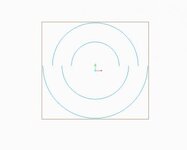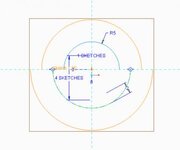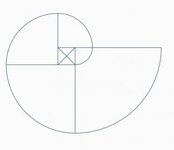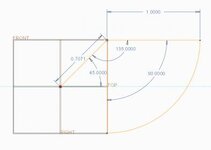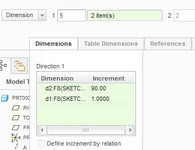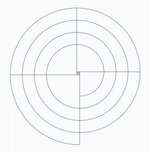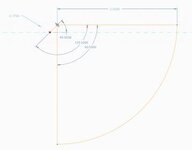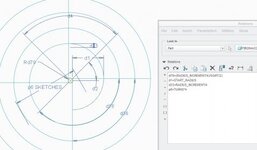Now, everybody (yes, EVERYBODY) will be wondering: "is it possible to build a fibonacci spiral with equations?" Advantages: you have a single curve and not different arcs, plus with respect to a simple spiral built in equations for each point on a fibonacci spiral the distance between turns is exactly the same.
Of course there are some tricks to use here, but it can be done. First issue is to find a way to "move" the arc origin around the starting square, then the hardest hurdle is to "step" change the radius of curvature. In equations you CANNOT use mod, ceil, floor or trunc statements (actually trunc doesn't exist, I have a complex mix of floor and ceil to substitute that), you can't use booleans. So all is lost? Not at all. Of course I could use some evalgraph magic, but I'd rather build a long, impossible to decipher equation set so that the whole spiral is in asingle datum curve from equation feature.
Here is the equation:
R0=P_R0
RSTEP=P_RSTEP/4
NTURNS=P_NTURNS
narcs=nturns*4
delta=rstep/2
zerox=-sin(t*90*narcs)
zeroy=cos(t*90*narcs)
xstep=if(zerox>0,delta,-delta)
ystep=if(zeroy>0,delta,-delta)
curturndec=t*narcs/40
curturndecn=if(curturndec>1,1,0)+if(curturndec>2,1,0)+if(curturndec>3,1,0)+if(curturndec>4,1,0)+if(curturndec>5,1,0)
curturndecn=curturndecn+if(curturndec>6,1,0)+if(curturndec>7,1,0)+if(curturndec>8,1,0)+if(curturndec>9,1,0)+if(curturndec>10,1,0)
curturn=t*narcs/4-curturndecn*10
curturnn=if(curturn>1,1,0)+if(curturn>2,1,0)+if(curturn>3,1,0)+if(curturn>4,1,0)+if(curturn>5,1,0)
curturnn=curturnn+if(curturn>6,1,0)+if(curturn>7,1,0)+if(curturn>8,1,0)+if(curturn>9,1,0)+if(curturn>10,1,0)
curarc=t*narcs-curturnn*4-curturndecn*4*10
curarcn=if(curarc>1,1,0)+if(curarc>2,1,0)+if(curarc>3,1,0)+if(curarc>4,1,0)
ra=r0+Rstep*curarcn+4*Rstep*curturnn+40*Rstep*curturndecn
ra=if(t==1,ra+Rstep,ra)
x=xstep+ra*cos(t*90*narcs)
y=ystep+ra*sin(t*90*narcs)
Very straightforward

The first part is the trick to "move" the origin, I couldn't use step function so a check on a sinusoidal curve was used. The second part is the toughest: it's used to determine in which "arc" we are to calculate which radius to apply. It does this first determining in which "tens of turns" we are, then in which "turn" and then in which "arc" (a turn is 4 arcs). In this way the curve can have up to 100 turns. Last part is the simple drawing routine. Oh at the beginning global parameters are passed to the local parameters.
Believe it or not, it works!

